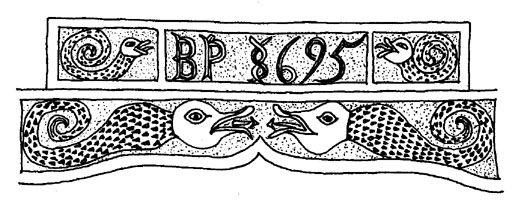| JOURNAL 1999 |
| North Craven Heritage Trust |
We began the walk on a clear, sunny autumn afternoon, crisp underfoot. We went the way Settle folk would have walked to their church, St Alkeldas - the mother church at Giggleswick - by going down Kirkgate and crossing the river close to the position of the old ford. From the church we took the old road to Close House past Giggleswick School, zigzagging up Dallicar Lane by the old green road and musing about the bumpy journey the carriage or similar conveyance would have had. We noticed where the overhead line buckets had crossed the land, going from Giggleswick Quarry to Giggleswick Station, to transport the burnt lime to its destination by rail. Field names proved fascinating - Crag field, the Oaks, Brackenbottom - but why Kiln Hill on millstone grit? In fact the Kilns in question would have been Saxon in origin and would have burned bracken, not lime, to produce potash for the 'fulling' or 'felting' of woollen cloth.
Arriving at Close House we noticed that the road continued on under the iron bridge (dated 1847) of the railway and would, in about a mile, join the original York to Lancaster road. We paused here to reflect on the changes made in the 17th and 18th centuries.
The Cliffords of Skipton Castle owned much of the land in NW England. Around 1600 Sir George Clifford was the Queen's Champion and wore her glove in his hat. He spent a fortune at Court and emulated Sir Francis Drake by financing a sailing ship and 12 expeditions to the Spanish Main, all of which failed. To raise more money he sold many of the tenancies of his farms to his tenants, who then becoming more affluent, were able to undertake alterations to their homes to improve their lifestyle.
From the parish records it appears that there were always 2 homesteads and at least 2 families at Close House. The Manor House itself has been 2 homes for the past 100 years - the country house renovated and improved in the 19th century. The farmhouse showed older features - the bacon hooks, the big arched fireplace of dressed stone and the dairy with thick slate shelves for salting bacon and keeping milk, cream and butter cool in the days before fridges.
The families who lived there included the Carr family in the 16th century, possibly a branch of the Stackhouse family of Carrs, one of whom (1480-1507) had founded Giggleswick School. In the 17th & 18th centuries the Frankland family was prominent. Richard Frankland was the famous nonconformist founder of the Rathmell Academy. He was twice excommunicated, once for reproving Charles II to his face, bidding him 'to reform your life, your family, your kingdom and the church'. He was later publicly absolved. Dated renovations can be attributed to the Franklands, the front door showing '1675 REF', a beam inside the top kitchen '1688 REF' and a lintel over the bottom barn '1720'. The house had its roof raised, the front was improved both inside and out and the outside rendered.
In the 19th century the Procter family continued the embellishments. The front windows and ceilings were again altered, some of the walls were panelled and wood block floors laid to bring the house up to date as a Victorian home for gentle folk of the time. A terrace of 3 gardens was created and a greenhouse erected. A tree lined drive was made about 1890, parallel to the old road, and leading to Giggleswick railway station.
We walked down the drive parallel to the road, which the carts would have taken years ago, carrying corn to be ground at Runley Bridge. We passed the Plague Stone, a reminder of the Great Plague raging here from 1660 onwards, finally arriving at Gildersleets, which is no longer a working farm It is said that here during the Civil War, about 1640, there was brush between a party of Royalists going to the defence of Skipton Castle, intercepted by General Lambert (of Calton near Airton) leading Parliamentary forces. From Gildersleets we noted where the old Ford crossed the river to Runley Mill, but stayed on the west side along the bank with a lovely view of the modern Anley House and so back to Settle, to savour a hot drink and reflect on a year of the best walks yet.
Phyllis Houlton

J1999p20_25_files/tmpDBE-6.jpg
Chair carving - Long Preston Church
Diana Kaneps